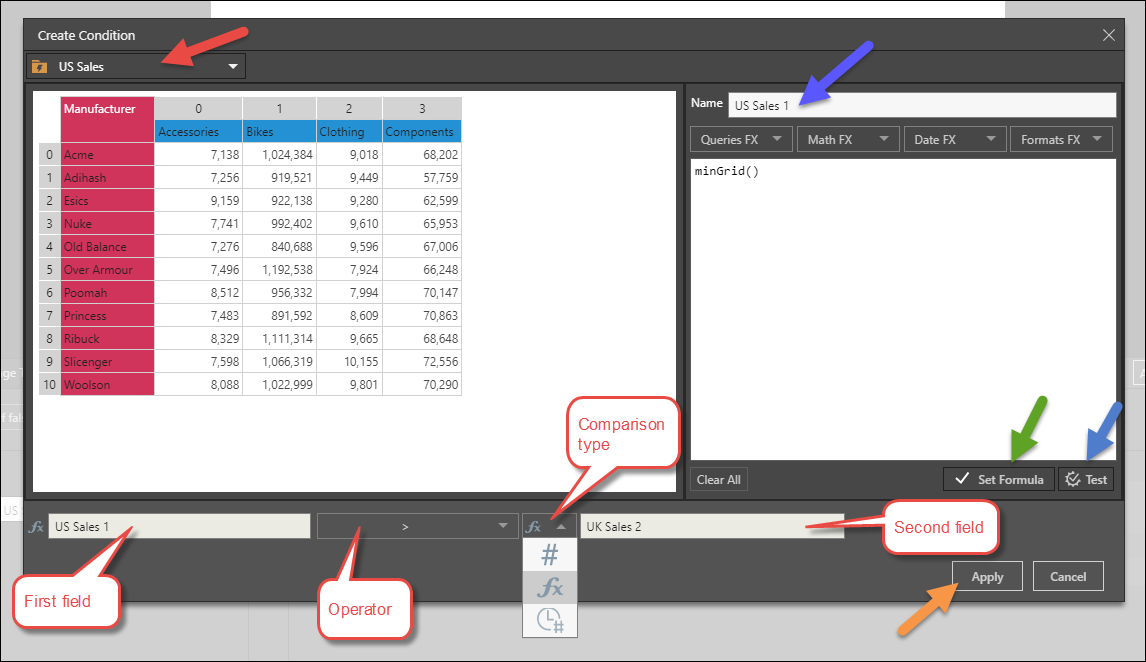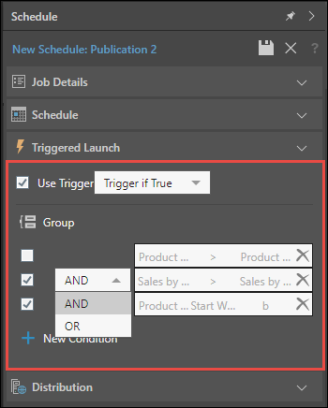Triggered Launch
Triggers can also be used when building Alerts, to conditionally trigger an alert based on given conditions.
These conditions are set from the Triggered Launch panel of the publication scheduler, in the Create Condition dialog. This dialog is also used when configuring dynamic text, dynamic images, and alert triggers.

Configure a Triggered Launch
- Check the box to include triggers for the schedule.
- You can determine the launch of the scheduled item to be either when the conditions are met or not met, by selecting Trigger if True or Trigger if False.
- Delineate the condition’s formula by clicking on “New Condition” (blue plus).
- The Create Condition dialog will appear.
Create Condition Dialog
- Insert the trigger condition in the fields along the top of the dialog. The first field must contain a dynamic function, and the second field can contain either a dynamic function or a static value (which can be either numeric or textual):
- With the first field selected, find the relevant grid in the Content tree (red arrow below).
- Select the relevant cell or grid component to add it to the formula window on the right. Add a formula using the drop down menus. To specify the formatting of the cell value, highlight it and select a format.
- Name the formula (purple arrow); the default name is the name of the content item.
- Test your selection or formula (blue arrow) and then click Set Formula (green arrow). The formula will be injected into the first field.
- Select the required operator. This can be numeric (equals, greater than, less than, etc) or textual (starts with, contains, does not contain, etc).
- Select either Compare to Static Value (#), Compare to Dynamic Function (fx), or Compare to Last Updated Value, in order to add the second field.
- If you've selected compare to static value, enter the value in the second field, then test and .click Set Formula.
- If you've selected compare to dynamic function, find and select the required grid from the Content folders, and build the required formula. Test and click the green apply button. Click here for a list of dynamic functions.
- If you've selected compare to last updated value, find and select the required grid from the Content folders, and select the required cell(s). Test and click Set Formula. This option compares the current value of the given cell(s) with their previous updated value (i.e. the value this schedule, compared with the value last schedule).
- When you've built the condition, click the lower Apply button (orange arrow). The condition will appear in the Triggered Launch window of the Schedule panel.

-
You can add multiple conditions by clicking the New Condition button again.
-
If you've added multiple conditions, select the relevant checkbox and choose either AND or OR.
-
To create a group of conditions, select the relevant conditions and click the Group button. To remove the group, click the orange group bar (ensuring the conditions are not selected).
